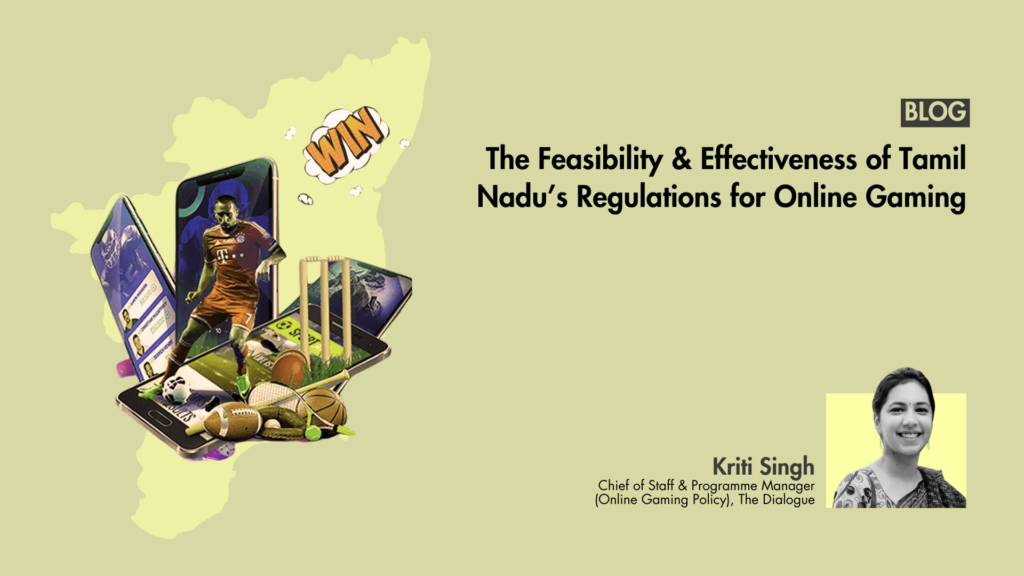1. Background
The growing concerns around overspending of both time and money on online gaming by netizens, especially minors, have been a significant concern globally. This has led many governments to adopt a paternalistic approach by imposing restrictions on gaming time. The Tamil Nadu Online Gaming Authority (Real Money Games) Regulations 2025 follow this trend by mandating warning messages when a user plays for over an hour, with pop-up alerts every 30 minutes. The regulations also enforce a mandatory “cool-off” period between 12 am and 5 pm, during which logins are prohibited. The companies must also facilitate “…to fix a daily, weekly and monthly monetary limit for each player. ”
The regulations prohibit minors under 18 from accessing real-money gaming platforms to strengthen age-gating and player verification. Section 4(i) aligns the consent mechanism for free-to-play versions of real-money games with the Digital Personal Data Protection Act 2023 (DPDP Act). For pay-to-play versions, the regulations require Know Your Customer (KYC) verification at the initial login stage rather than at the withdrawal stage, shifting from the current standard practice under IT Rules and industry self-regulation. The KYC process mandates Aadhaar-based verification linked to an OTP-based authentication system.
These legislative restrictions reignite a long-standing debate: Who should be empowered to regulate gaming time and spending— governments, parents, or users? Regulators justify these measures on consumer protection and mental health grounds, while critics argue they infringe on individual freedoms and hinder industry growth. Notably, such legislative restrictions often apply to minors rather than legal adults. This may infringe on an adult user’s right to freedom of choice and autonomy. Moreover, since gaming is a legitimate business, the restrictions that disrupt user engagement may impact the industry’s economic viability.
While protecting vulnerable users is essential, a balanced regulatory approach—focusing on self-regulation, user awareness and autonomy, and targeted interventions—would be more effective than broad legislative mandates that risk infringing on fundamental rights.
2. Feasibility & Challenges
Tamil Nadu’s Online Gaming Authority (Real Money Games) Regulations 2025 introduce strict measures for player protection, but their feasibility depends on technological constraints, geographic limitations, industry compliance, and user adaptation. Implementing these rules poses significant challenges since online gaming services operate beyond state and national boundaries.
2.1. User Protection
While the regulations aim to curb excessive gaming, enforcing these restrictions presents several challenges:
Gaming Addiction vs. Regulatory Control
- Studies show that gaming addiction stems from behavioural patterns rather than just time spent playing. Limiting gaming hours may not address compulsive spending or psychological dependence.
- The regulations lack intervention-based or incentive-driven mechanisms, such as counselling, digital wellness tools, or voluntary gameplay limits—strategies that have proven more effective for long-term behavioural change.
Circumvention via Alternative Platforms
- Users can switch to unregulated or illegitimate platforms not bound by state-level restrictions.
- Proxy servers may allow players to bypass local restrictions.
Aadhaar-Based KYC & Privacy Concerns
- There may be instances where users may share Aadhaar details with older individuals to bypass age restrictions.
- The blanket hours may push users toward illegitimate platforms, exposing them to more significant risks.
Parental Controls as an Alternative Solution
- Global models and India’s Digital Personal Data Protection Act propose opt-in parental controls for free-to-play versions, which have shown greater acceptance and effectiveness than outright bans.
- Tamil Nadu’s blanket approach does not offer user-driven customisation, potentially leading to lower compliance and frustration among adult users.
2.2. Implementation & Operator Perspective
Gaming operators will face significant compliance burdens due to Tamil Nadu’s stringent mandates.
Technological Constraints on Server-Level Implementation
- Enforcing gaming time bans and session tracking requires real-time monitoring, increasing infrastructure demands and introducing privacy-invasive interventions beyond the Digital Personal Data Protection Act’s data minimisation principle.
- Server-wide restrictions may cause latency issues, especially for platforms serving users across different states and time zones.
- Imposing strict playtime bans requires server-side interventions, which may discourage users from engaging with legitimate platforms.
Disruption of Business Models
- Many real-money gaming companies rely on engagement-based revenue models.
- In several real-money gaming formats, individual sessions last less than 10 minutes or are tied to live events, making compliance with these mandates technologically challenging.
Overlap with Existing IT & Gaming Guidelines
- Some provisions duplicate requirements in the IT Rules, 2021 and the Reserve Bank of India (RBI) guidelines on digital payments.
- Companies already comply with the IT Rules by enforcing an 18+ age restriction and conducting RBI-mandated KYC verification for users.
2.3. Government & Enforcement Perspective
While the government aims to curb online gaming risks, enforcing compliance remains complex.
- A lack of inter-state or central regulation could create legal challenges.
- Tracking individual playtime requires mass ISP or platform-level surveillance, raising privacy and feasibility concerns.
- Operators may struggle to enforce region-based restrictions due to player mobility and device sharing.
3. Game Session Durations & Engagement Models
Different gaming formats follow distinct engagement patterns, making blanket time limits ineffective. Below is a breakdown of game session durations and how various formats operate.
3.1. Real Money Games (RMG) – Short Session Play
Game Session Length: Typically 5-6 minutes per match.
Nature of Play:
- RMG platforms host quick-fire games like Ludo, rummy, hyper-casual games, and fantasy sports, which rely on live sporting events.
- Players engage in short bursts rather than extended sessions.
Why Time-Based Restrictions May Not Work:
- Since games are inherently short, players can simply restart sessions using multiple logins or VPNs after reaching the time limit.
- Restrictions may push players toward unregulated platforms instead of reducing overall playtime.
3.2. Fantasy Sports and Platforms – Event-Based Engagement
Game Session Length: Engagement depends on live sporting events.
Nature of Play:
- Players create teams before a match and track performance throughout the game or select their opinion.
- Unlike other games, users engage only at key moments of a live match or event rather than playing continuously.
Impact of Regulations:
- These formats do not follow traditional gaming patterns, making time-based restrictions impractical.
- If users are locked out due to time limits, they may lose ongoing game sessions, leading to dissatisfaction and a shift toward illegitimate platforms.
3.3. Casual & Hyper-Casual Games – Varying Play Durations
Game Session Length:
- Sessions typically last from a few to 20 minutes, with some players engaging in multiple consecutive sessions.
- Casual games (e.g., Candy Crush, Ludo, Subway Surfers) cater to on-the-go play, while hyper-casual games focus on quick engagement.
Nature of Play:
- Casual games offer flexibility, allowing for short bursts of play or longer sessions, depending on user preference.
- Hyper-casual games usually follow an ad-driven or microtransaction-based model, encouraging frequent, short-duration sessions.
- Unlike other formats, these games do not require extended, continuous play and often rely on habit formation through repetitive engagement rather than long sessions.
Feasibility of Time Restrictions:
- Casual players may not experience direct disruption, as these games are designed for short bursts of play.
- Frequent session restarts and intermittent play behaviour make strict time limits ineffective.
- Competitive or high-engagement players (e.g., leaderboard chasers and high-score seekers) may find time restrictions intrusive, particularly during time-limited events.
- A one-hour warning system does not apply universally, as players tend to engage in multiple short sessions rather than continuous play.
4. Recommendations
Government-mandated time limit restrictions often assume that extended playing time equals addiction. The United Nations (UN) and World Health Organisation (WHO) recognise the potential risks of excessive gaming. In 2019, the WHO included ‘Gaming Disorder’ in the International Classification of Diseases (ICD-11), defining it as:
A pattern of persistent or recurrent gaming behaviour (digital or video gaming), which may be online or offline, characterised by:
- Impaired control over gaming (e.g., onset, frequency, intensity, duration, termination, context).
- Increasing priority given to gaming over other life interests and daily activities.
- Continuation or escalation of gaming despite negative consequences.
Notably, the ‘gaming disorder’ criteria do not specify a particular amount of playtime. However, including gaming disorder in global health frameworks has led governments to adopt restrictive policies similar to Tamil Nadu’s. Countries like China, South Korea, and Germany have introduced regulatory frameworks to manage gaming addiction among children, with varying levels of enforcement and effectiveness.
To effectively address this issue, it is crucial to distinguish between regular gaming (unproblematic behaviour) and gaming disorder (problematic behaviour) based on the impact on the user and their response to those effects.
For example:
- Problematic Gaming: A cab driver uses a real-money gaming app while ignoring ride requests, repeatedly telling himself, “Just 10 more minutes.” This disrupts his livelihood, leads to financial mismanagement, and prioritises gaming over essential expenses.
- Healthy Gaming: The same cab driver plays only during designated break times as entertainment—without affecting his earnings, financial responsibilities, or personal life.
Thus, the Tamil Nadu gaming regulations’ mandate on time limits will not address the concerns outlined in the example. If restricted, the cab driver might turn to illegal platforms without responsible gaming measures and attract users with “tax-free” incentives, exposing him to higher financial and regulatory risks. Alternatively, he may bypass restrictions by creating multiple accounts, using VPNs, or switching to unregulated platforms—rendering time limits ineffective.
Since RMG formats are structured around short-session gameplay rather than prolonged engagement, imposing time-based curbs fails to address the root issue. Instead of mitigating problematic gaming behaviour, these restrictions may push users toward riskier alternatives while failing to impact those who engage responsibly.
A More Effective Approach
A behavioural awareness and self-regulation model would be more effective than rigid time limits. Key recommendations include:
- User-Set Limits: Allow users to set their own gaming time and spending limits based on personal preferences, rather than imposing blanket restrictions.
- Detailed Tracking: Provide gaming history and expenditure breakdowns to help users make informed decisions.
- Opt-In Consent: Replace auto-imposed restrictions with clear, opt-in consent mechanisms for time and spending limits.
- Cool-Off Periods: Implement customisable cool-off periods, allowing users to take breaks voluntarily.
- Real-Time Monitoring: Use real-time progress tracking and nudges to help users monitor their gaming habits.
- Adaptive Wellness Reminders: Trigger in-game wellness reminders only when abnormal patterns (e.g., excessive play without breaks) are detected, rather than generic time-based warnings.
- Access to Support: Offer in-app access to digital wellness tools, counselling services, and peer-support communities.
- User-Controlled Escalation: Enable anonymous escalation mechanisms for those seeking help with their gaming behaviour.
- Educational Awareness: Conduct workshops on responsible gaming to promote mindful gaming habits and educate users on potential risks. Focus particularly on minors transitioning to legal adulthood, equipping them with the knowledge and tools to make informed gaming decisions.
- Policy Based on Research: Quantitative studies should inform policy interventions to ensure effective redressal and implementation.
- Multi-Stakeholder Collaboration: A collaborative approach involving government, the private sector, and civil society can foster a comprehensive, whole-of-society framework.
By shifting focus from blanket restrictions to self-regulation, financial safeguards, and awareness-building, policymakers can foster a sustainable and responsible gaming ecosystem while preventing unintended consequences.
References
Ryan, A. (2021, December 13). Video gaming addiction: A case study of China and South Korea. Towson University Journal of International Affairs. https://wp.towson.edu/iajournal/2021/12/13/video-gaming-addiction-a-case-study-of-china-and-south-korea/
King, D. L., Delfabbro, P. H., & Griffiths, M. D. (2012). Evaluating existing strategies to limit video game playing time. Cyberpsychology, Behavior, and Social Networking, 15(10), 527–531. https://doi.org/10.1089/cyber.2012.0182

